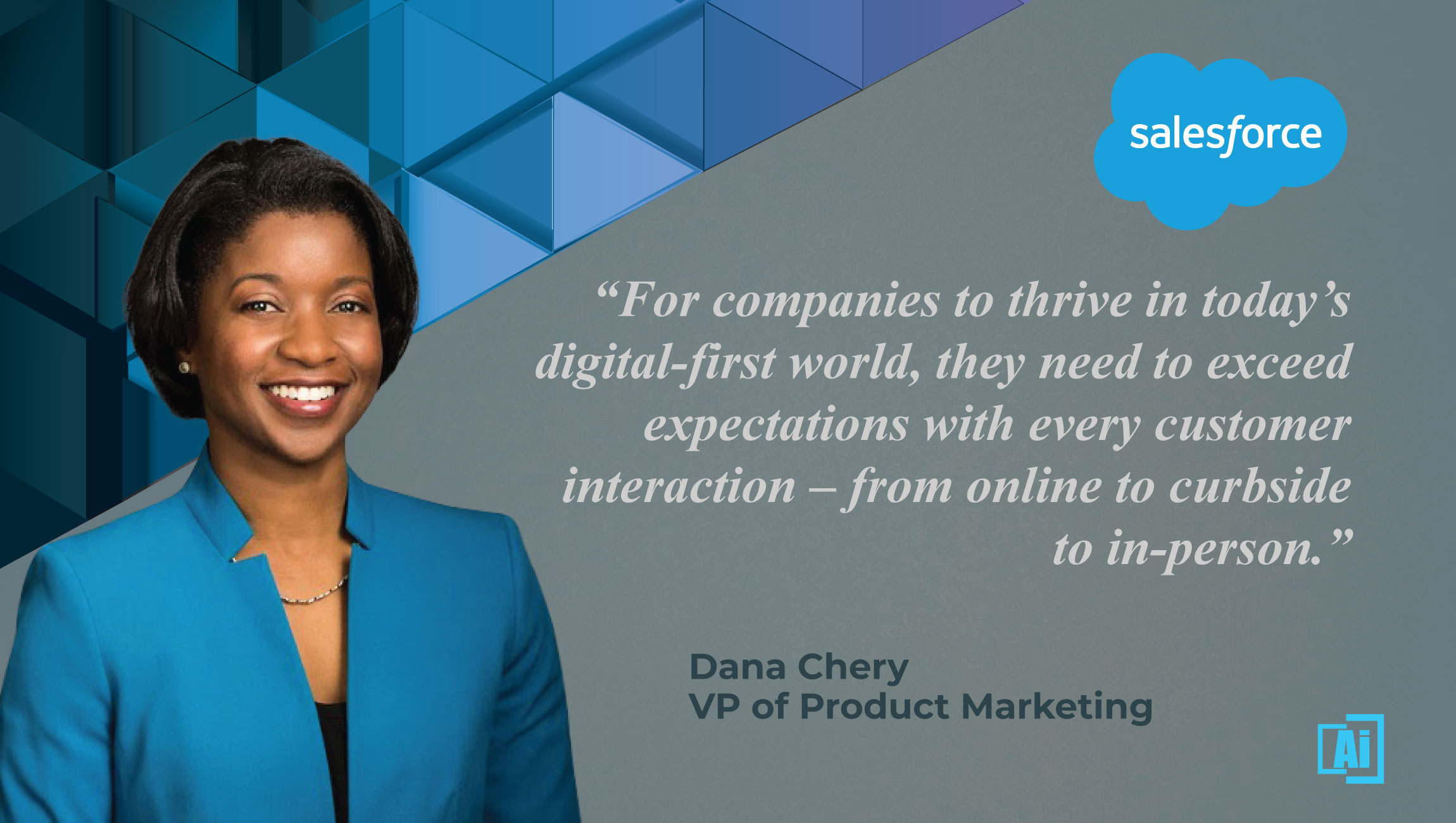AiThority Interview with Dana Chery, VP of Product Marketing at Salesforce

Hi Dana, please tell us about your role and the team you manage at Salesforce.
Sure thing. I lead a talented team of marketers responsible for global go-to-market strategies, messaging, launches, content marketing, customer community building, events and sales enablement across the multi-billion dollar Service Cloud business. We work closely with businesses across all industries and segments to help them deliver digital-first customer and employee experiences from anywhere.
Also Read: AiThority Interview with Nick Cicero, VP Strategy at Conviva
How did the role of customer service evolve through the pandemic months? How did the demand for Service Cloud evolve?
Last year, our world shifted overnight, and unexpectedly everything went digital. No matter the job or industry, we all found ourselves needing to dramatically change the way we worked.
One of the lines of business hit the hardest by this shift was customer service. As we navigated the uncertainties of last year altogether, customer service became the front line to get us answers to our most important questions, like when to expect an order for medication and how to get a bank loan.
As customers sought out more help than ever, we saw huge spikes in service volumes, leaving support teams struggling to manage their workloads.
Previously, service agents would handle customer requests on one support channel at a time, turning to coworkers sitting next to them to ask questions, flagging down a supervisor who was walking the halls of the contact center for help — but last year changed all of that.
Businesses had to move service operations out of the contact center and into the living rooms of service agents, technicians, and dispatchers. That transition to remote work would not have been as successful as it was without the right digital solutions provided by Service Cloud.
In many cases, we helped businesses establish new, entirely digital infrastructures overnight and empowered agents and field service reps to spend less time orchestrating manual processes. That way, they could spend more time strengthening customer relationships and helping customers navigate the complexities of last year.
As a result of this renewed emphasis on customer service, we saw a huge increase in demand for Service Cloud, which has become the fastest-growing product at Salesforce.
We anticipate further demand for Service Cloud as businesses continue to recognize the strategic impact that seamless, contextual service has on driving real business results. In fact, 91% of customers say a positive customer service experience makes them more likely to make another purchase, according to our State of the Connected Customer report.
Also Read: AiThority Interview with Anna Luo, VP of Customer Innovation and Marketing at Jivox
What is the future of CRM for contact centers? How would Salesforce Service Cloud transform the overall contact center experience?
For companies to thrive in today’s digital-first world, they need to exceed expectations with every customer interaction – from online to curbside to in-person. Service employees should be empowered to quickly and seamlessly help whether they are working from home, are in the field, or are working in a hybrid model.
In order to do that, businesses need a unified, digital platform with CRM, digital channels, voice, field service, workforce engagement, AI, and automation. This is where Service Cloud comes in. We recently introduced the next generation of Service Cloud to support customer engagement and provide connected, personalized service from anywhere on one digital engagement platform.
When it comes to the contact center, we know many business leaders are planning to maintain remote or hybrid work, as the pandemic exposed an opportunity to deliver great service from anywhere. As part of our recent announcement, we discussed how Service Cloud Voice brings together phone, digital channels and CRM data in one central view for service agents, and offers the agent real-time call transcription and AI-powered guidance on recommended next steps.
For the first time, customers can connect their existing phone systems into Service Cloud with Service Cloud Voice for Partner Telephony, creating a unified agent and digital channel experience to deliver faster, smarter, and more personalized service.
And in this new environment, it’s more critical than ever to have the right customer service agent — with the right skills —talking to the right customers at the right time. Service Cloud Workforce Engagement is a new workforce planning product that uses artificial intelligence to help service leaders predict how many requests will come into the contact center, and on which channels including phone, email, webchat, text and social. With these types of solutions, service leaders can intelligently plan staffing needs, matching agents to work based on their skills, availability and shift preference.
Which industries are most likely to benefit the most from adopting Service Cloud?
Across all industries, driving greater efficiencies across, to elevate customer engagements, is imperative. For example, we are currently working with a top beauty brand to bring high-touch service to every aspect of their business.
Having a 360-degree view of their customer within Salesforce has given this brand the ability to build empathy and a connection with the consumer beyond product questions and transactions. In addition to consumer goods, we support businesses of all sizes in finance, healthcare, retail, hospitality and many others sectors.
Other industries that could benefit from Service Cloud technology are ones that are involved in the “reopening of society.” For example, outside of the contact center, field service has undergone a massive transformation as in-person safety and new precautions have become essential for how businesses reopen and effectively stay open.
Office buildings, sports stadiums, and malls will need to ramp up to address throngs of people excited to be back together in the community again. Sectors including food service, manufacturing, sanitation, and utilities, in particular, are increasing their use of Salesforce Field Service to more efficiently schedule resources and prepare for the surge in infrastructure and servicing demands– everything from elevator maintenance, lights and air quality systems as people return to work, concerts, sporting events, airports, and museums. These indoor spaces have largely sat vacant for the last 12 months, and require checks and maintenance before they are ready for prime time.
As companies continue to limit in-person interactions and prioritize employee health and safety, delivering trusted and effective visual support will become increasingly important. Mobile technicians can reduce time on site by using Visual Remote Assistant, which allows technicians and agents to see what the customer sees through video support, so they can resolve complex issues from anywhere.
Also Read: AiThority Interview with Alon Leibovich, Co-Founder and CEO at BrandTotal
Could you tell us about the AI and Machine Learning features included in Service Cloud?
We know connecting every service channel to the contact center and field service is powerful because it allows companies to engage customers with customers everywhere. But when companies are also able to leverage AI-powered tools and automate business processes, it means they can boost workforce productivity digitally.
The scale and productivity gains are huge: a 27% increase in productivity, according to our Salesforce Success Metrics Pulse Survey 2020. This is because service teams can spend less time focusing on manual processes and more time listening to customers and sharing new insights across the business.
These days, automated workflows are quickly becoming a go-to solution for companies seeking to manage higher case volumes more efficiently and do more with fewer resources. Automation allows companies to make complex business processes simple, by automating repetitive and manual tasks, making every engagement more efficient. Getting started can be daunting, but with point and click builders and out-of-the-box templates, companies can set up flows faster than ever.
For example, in the past year, we saw Einstein Bot conversations surge by 706%. Einstein Bots are intelligent chatbots that simulate human conversations and can quickly resolve common issues like processing a return or checking flight status. In doing so, they empower agents to devote more time and resources to complex problem-solving and customer interactions. In just a few clicks with Salesforce’s low-code capabilities, customers were able to deploy a new chatbot by leveraging Pre-Built Einstein Bots to assist with service requests.
At the end of the day, customers expect to see one unified experience with digital at the core. That means when we pull back the curtain on those experiences, they must be orchestrated by unified processes, collaborative teams, and connected data. Only Service Cloud can natively bring automation, workforce engagement, and every customer interaction together on a single platform. When the entire workforce from the agent on the phone to the IT pro in the back office are focused on serving the customer, making every engagement seamless isn’t only possible, it’s transformational.
Thank you, Dana! That was fun and we hope to see you back on AiThority.com soon.
Dana Chery is a VP of Product Marketing at Salesforce. In this role she leads product and solutions marketing for Service Cloud. Prior to joining Salesforce, Dana led CRM and marketing initiatives at media companies in Chicago and New York. She also serves on the board of GreatSchools, a national educational non-profit. Dana received an M.B.A. from the Kellogg School of Management at Northwestern University and a B.A. in Economics from Tufts University.


Comments are closed.